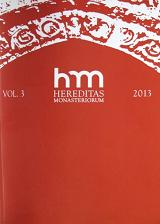Les sources comptables, documents de gestion et d’administration des couvents mendiants en Hongrie médiévale
Accounting sources as documents of management and administration of mendicant friaries in medieval Hungary
Author(s): Beatrix F. RomhányiSubject(s): History
Published by: Laboratoire de Recherches sur l'Histoire des Congregations et Ordres Religieux (LARHCOR)
Keywords: mendicant orders; friars; economy of mendicant convents; income of mendicant convents; expenses of mendicant convents; accounting sources; account books; medieval Hungary; Franciscans of Sopron; Carmelites of Eperjes; Austin Hermits of Bártfa
Summary/Abstract: The account books in general offer the best possibility to analyze the management and the everyday life of the friaries. However, there are but a few surviving in medieval Hungary and even these are fragmentary. Their common feature is that they were not prepared for the internal use of the convents but for the patron, i.e. for the town and for its council. This fact influenced the content, too, revealing a special aspect of the relation between the convent and the community that had the patronage rights. Beside the account books of franciscains friary of Sopron which are the best known sources of this type, there are some fragments of the Carmelite friary of Eperjes (Prešov), of the Austin Hermits of Bártfa (Bartfeld, Bardejov) and of the Dominican convent of Selmecbánya (Schemnitz, Banská Štiavnica). The picture gained from these fragmentary sources is very incomplete. Nevertheless, a certain number of characteristics could be detected through their analysis: the separation of the management of the community from that of the church, the secondary importance of the landed estates and of other properties compared to different forms of alms, as well as the changing role of the procuratores and of the friars by the end of the Middle Ages (late 15th – early 16th century). The account books of Sopron – being the most detailed documents – reflect a considerable flexibility in the economic life of the convent, as well as the prudent administration. In Sopron both the main expenses and incomes were connected to the production, especially to the wine production. Despite some common features there was no uniform economic model at the mendicant orders in this period. Presumably, there was a certain difference between the management of the Transdanubian and north-Hungarian convents and the Transsylvanian friaries, respectively, which is reflected in the absence of account books among the sources connected to latter group of mendicant institutions.
Journal: Hereditas Monasteriorum
- Issue Year: 2013
- Issue No: 3
- Page Range: 77-96
- Page Count: 20
- Language: French

